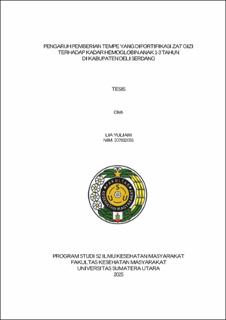Pengaruh Pemberian Tempe yang Difortifikasi Zat Gizi terhadap Kadar Hemoglobin Anak 1-3 Tahun di Kabupaten Deli Serdang
The Effect of Giving Nutrient-Fortified Tempeh on Hemoglobin Levels of 1-3 Years Old Children in Deli Serdang Regency

Date
2025Author
Yuliani, Lia
Advisor(s)
Aritonang, Evawany Yunita
Sudaryati, Etti
Metadata
Show full item recordAbstract
Kabupaten Deli Serdang, one of the largest districts in North Sumatra, has a significant population of toddlers, comprising a quarter of the province's total. An initial survey revealed that out of 36 tested children, 55.6% had hemoglobin levels below 11 gr/dL, indicating potential anemia. The district has also seen a rise in soybean consumption, increasing from 5.9 g/capita/day in 2021 to 15.5% in 2022, and is a key producer of soybean tempeh. This study aims to investigate whether fortified tempeh, enriched with iron, zinc, and Vitamin C, can serve as an alternative for addressing anemia in children aged 1-3 years in Kabupaten Deli Serdang, focusing on its impact on their hemoglobin levels. This type of research is a quasi-experimental, pretest-postest non-randomized control design at the Dalu Sepuluh Health Center, Tanjung Morawa District. The number of samples in
this study was 84 children. The results of the study showed that the average intake of calories, carbohydrates, proteins, fat, Fe, Zinc and vitamin C is still below the nutritional adequacy rate. There is a difference in hemoglobin levels of children 1-3 years before and after consuming fried tempeh non fortified and tempe
fortified with iron, zinc and also fried tempeh fortified with iron, zinc, and vitamin C, and there was no significant influence on hemoglobin levels between the four intervention groups.
Collections
- Master Theses [2429]
